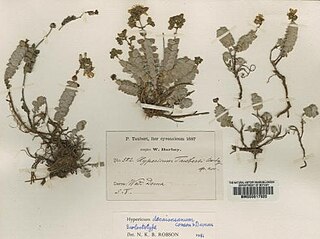
Hypericum perforatum, commonly known as St John's wort, is a flowering plant in the family Hypericaceae. It is a perennial plant that grows up to one meter tall, with many yellow flowers that have clearly visible black glands around their edges, long stamens, and three pistils. Probably a hybrid between the closely related H. attenuatum and H. maculatum that originated in Siberia, the species is now found worldwide. It is native to temperate regions across Eurasia and North Africa, and has been introduced to East Asia, Australia, New Zealand, and parts of North and South America. In many areas where it is not native, H. perforatum is considered a noxious weed. It densely covers open areas to the exclusion of native plants, and is poor grazing material. As such, methods for biocontrol have been introduced in an attempt to slow or reverse the spread of the species.

Hypericum is a genus of flowering plants in the family Hypericaceae. The genus has a nearly worldwide distribution, missing only from tropical lowlands, deserts and polar regions. Many Hypericum species are regarded as invasive species and noxious weeds. All members of the genus may be referred to as St. John's wort, and some are known as goatweed. The white or pink flowered marsh St. John's worts of North America and eastern Asia are generally accepted as belonging to the separate genus TriadenumRaf.

Hypericum concinnum is a species of flowering plant known as gold-wire or goldwire. It is in the St. John's wort family, Hypericaceae. It is the only species in the section Hypericum sect. Concinna.

Hypericum hypericoides, commonly called St. Andrew's cross, is a species of flowering plant in the St. John's wort family, Hypericaceae. It is native to the Southeastern United States, Mexico, Central America, and the Caribbean. Its preferred habitat is dry woods on acidic soil. It is a small shrub or shrublet that produces yellow flowers with four petals. There are, according to some classifications, 2 subspecies, hypericoides and multicaule. However, the latter of these is usually classified as a separate species, Hypericum stragulum.

Hypericum ericoides is a dwarf shrub in the flowering plant family Hypericaceae, section Coridium. It is found in eastern and southeastern Spain, Morocco, and Tunisia. Its preferred habitat is fissures in calcareous rocks in warm, sunny places, from 200 to 2,000 meters above sea level (MASL).
Hypericum addingtonii is a shrubby species of flowering plant in the family Hypericaceae. It is native to China and was described by Norman Robson in 1985.

Hypericum aegypticum is a species of flowering plant of the St. John's wort family (Hypericaceae) which is native to the Eastern Mediterranean. It was described by Carl Linnaeus in the second volume of his Species Plantarum in 1753, who named it after Egypt despite it not being distributed there. The plant is commonly known as shrubby St. John's wort or Egyptian St. John's wort in English. Like other members of section Adenotrias, it is found among limestone rocks in coastal areas. While it has been evaluated as threatened on the island of Malta, the species has no legal protections.
Hypericum was a British Thoroughbred racehorse and broodmare. Bred and owned by King George VI she was one of the best two-year-old fillies in England in 1945 when she won two of her four races including the Dewhurst Stakes as well as finishing second in the Middle Park Stakes. In the following year she became increasingly temperamental but after finishing second on her seasonal debut she won the 1000 Guineas despite throwing her jockey and bolting before the start. In her two subsequent races she finished fourth in the Epsom Oaks and unplaced in the Coronation Stakes. As a broodmare she had an enduring influence on the breed through her granddaughter Highclere.

Hypericum cerastioides is a species of perennial flowering plant in the St. John's wort family, Hypericaceae. It is the only species in the section Hypericum sect. Campylopus.

Hypericum sect. Adenosepalum is one of 36 sections in the genus Hypericum. Its type species is Hypericum montanum.
Hypericum assamicum is a species of flowering plant in the St. John's wort family, Hypericaceae. It is endemic to India. Hypericum assamicum is one of two species of Hypericum in the section Hypericum sect. Sampsonia.

Hypericum huber-morathii is a flowering plant in the family Hypericaceae, section Adenosepalum, and the type species of the Hypericum huber-morathii group.
Hypericum fissurale, known as cracked St. John's wort, is a flowering plant in the St. Johns's wort family (Hypericaceae) endemic to northeastern Turkey. It is considered critically endangered on the IUCN Red List due to its very limited distribution and declining population. It was first formally named by Jurij Nikolaewitch Woronow in 1912. It is a small perennial herb in the section Hypericum sect. Taeniocarpium, reaching around 22 cm (8.7 in) in height. Like most Hypericum species, it has flowers with five yellow petals and numerous stamens. Hypericum fissurale is closely related to Hypericum armenum.
Hypericum styphelioides is a perennial flowering plant in the St. John's wort family Hypericaceae. It is endemic to Cuba.

Hypericum coadunatum is a species of flowering plant of the St. John's wort family (Hypericaceae) that is found in the Canary Islands.
Hypericum somaliense is a species of flowering plant of the St. John's wort family (Hypericaceae) that is found in Somalia.

Hypericum tomentosum is a species of flowering plant of the St. John's wort family (Hypericaceae) that is found in the western Mediterranean.

Hypericum decaisneanum is a species of flowering plant of the St. John's wort family (Hypericaceae) that is found in the Libya.
Hypericum monanthemum is a species of flowering plant of the St. John's wort family (Hypericaceae) which is native to the Himalayan mountains.











